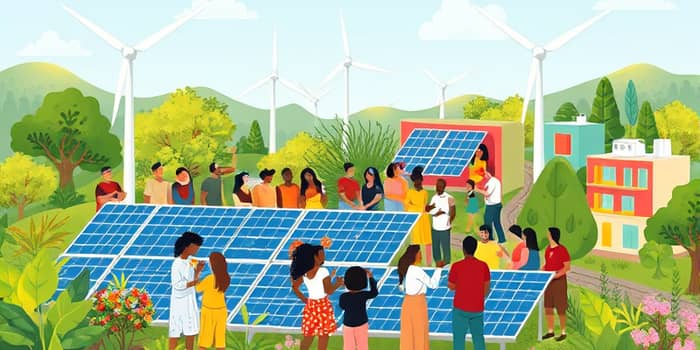In an era where climate change and resource depletion challenge our way of life, innovative financial solutions like eco-friendly loans are gaining prominence. These dynamic financing tools offer borrowers the chance to invest in renewable energy, energy-efficient upgrades, and green infrastructure. By tying capital to environmental goals, green loans align financial returns with sustainable outcomes, catalyzing a transition towards a low-carbon economy.
Whether you are a homeowner planning to install solar panels, a farmer exploring sustainable agriculture practices, or a business owner aiming to upgrade to electric vehicles, eco-friendly loans can provide the capital needed to bring environmentally conscious projects to life. This article delves into the world of green financing, exploring its nature, benefits, providers, and future prospects. With a comprehensive understanding of these instruments, you can make informed decisions and play your part in the global sustainability journey.
Understanding Green Loans
Green loans are specialized debt products designed to finance projects that make a substantial contribution to environmental objectives. Unlike traditional loans, the proceeds from green loans must be used exclusively for initiatives such as renewable energy installations, energy efficiency upgrades, and climate-friendly infrastructure improvements. Though reminiscent of green bonds, green loans exist within the private lending market, offering borrowers direct access to capital without the complexities of public issuances.
First introduced to support homeowners in adopting energy-saving home improvements, these loans have evolved to encompass a broad spectrum of sustainable projects across industries. From community-scale wind farms to eco-friendly retrofits in commercial buildings, green loans serve as a versatile tool in the fight against climate change.
Types of Sustainable Debt
- Green Loans: Activity-based loans for specific environmental projects, requiring clear allocation of proceeds.
- Sustainability-Linked Loans (SLLs): Behavior-based loans with interest rates tied to performance against sustainability targets.
- Green Bonds: Publicly tradable instruments similar to green loans, but accessible to a wider pool of investors.
- Social Bonds: Debt instruments for projects with positive social outcomes, such as affordable housing or healthcare facilities.
- Sustainability Bonds: Combining environmental and social benefits under one financing structure.
- Sustainability-Linked Bonds: Bond format that adjusts coupon rates based on achievement of ESG metrics.
Providers of Green Loans
- Clean Energy Credit Union: Offers customized loans with favorable terms for solar electric systems, geothermal units, and electric vehicles, with repayment periods of up to 20 years.
- Vermont Credit Union (VSECU): Provides no-upfront-payment loans with low rates and extended terms for energy-efficient home improvements and sustainable transportation investments.
- Commercial Banks: Many traditional banks have introduced green lending products to meet corporate and retail demand for eco-friendly financing.
Benefits of Green Loans
One of the most compelling advantages of green loans is the potential for significant long-term savings. For instance, installing solar panels can save borrowers between $10,000 and $70,000 over a 25-year warranty period. Geothermal heating and cooling systems may yield approximately $1,500 in annual savings over a 10- to 20-year payback period.
Beyond direct cost reductions, green loans contribute to a reduction in greenhouse gas emissions, aiding national and global climate goals. Borrowers also benefit from favorable terms such as lower interest rates and no prepayment penalties, making it easier to accelerate the repayment schedule and maximize financial gains.
Market Trends and Outlook
The global sustainable debt market surpassed US$1.6 trillion in 2024, marking an 8% increase from the previous year. Record issuance of green bonds made 2024 the second busiest year for sustainable bond markets, while sustainable fixed income funds saw historic inflows. This momentum reflects growing investor appetite for environmental, social, and governance (ESG) assets.
Regional dynamics continue to shape growth trajectories. Europe leads with robust regulatory frameworks and supportive policies, while North America experiences mixed signals amid political debates over ESG. Meanwhile, emerging markets in Australia, Japan, and the EMEA region are driving new opportunities, fueled by technological innovation and increasing corporate commitments to net-zero targets.
Regulatory Framework
Strong regulatory oversight is crucial to maintain integrity in green financing. The EU Taxonomy provides a clear classification for environmentally sustainable activities, helping to prevent greenwashing and enhancing investor confidence. In the United States, the SEC Climate Disclosure Rule and California’s Climate Disclosure Laws require transparent reporting of climate risks and opportunities.
Financial institutions are responding by integrating ESG criteria into lending practices and engaging corporate clients on sustainability journeys. These efforts align with objectives of the European Green Deal and global initiatives like the Task Force on Climate-related Financial Disclosures (TCFD).
Sectors and Applications
- Renewable Energy: Solar, wind, and hydropower projects driving clean electricity generation.
- Energy Efficiency: Home insulation, heat pumps, LED lighting, and smart building systems.
- Clean Transportation: Electric or hybrid vehicles, charging infrastructure, and e-bikes for urban mobility.
- Sustainable Agriculture: Precision farming, organic practices, and water-efficient irrigation systems.
- Green Infrastructure: Eco-friendly buildings, wastewater treatment, and urban green spaces.
Future Outlook
As sustainable financing moves from niche to mainstream, the market for eco-friendly loans is poised for continued expansion. Standardization of criteria and reporting will streamline adoption, while advances in renewable technologies and climate-smart solutions will generate fresh investment opportunities.
Borrowers and lenders alike stand to benefit from this evolution. By embracing eco-friendly loans, individuals, businesses, and communities can unlock capital for projects that deliver both financial returns and lasting environmental impact. In doing so, they become active participants in shaping a prosperous, resilient, and sustainable future for all.
References
- https://www.worldbank.org/en/news/feature/2021/10/04/what-you-need-to-know-about-green-loans
- https://online.hbs.edu/blog/post/types-of-sustainable-debt
- https://www.aspiration.com/resources/what-is-a-green-loan
- https://www.nordea.com/en/news/what-are-green-loans
- https://www.fibe.in/blogs/what-is-green-finance/
- https://www.tdsecurities.com/ca/en/sustainable-finance-outlook-2025
- https://www.comundo.io/blog-posts/green-loans










